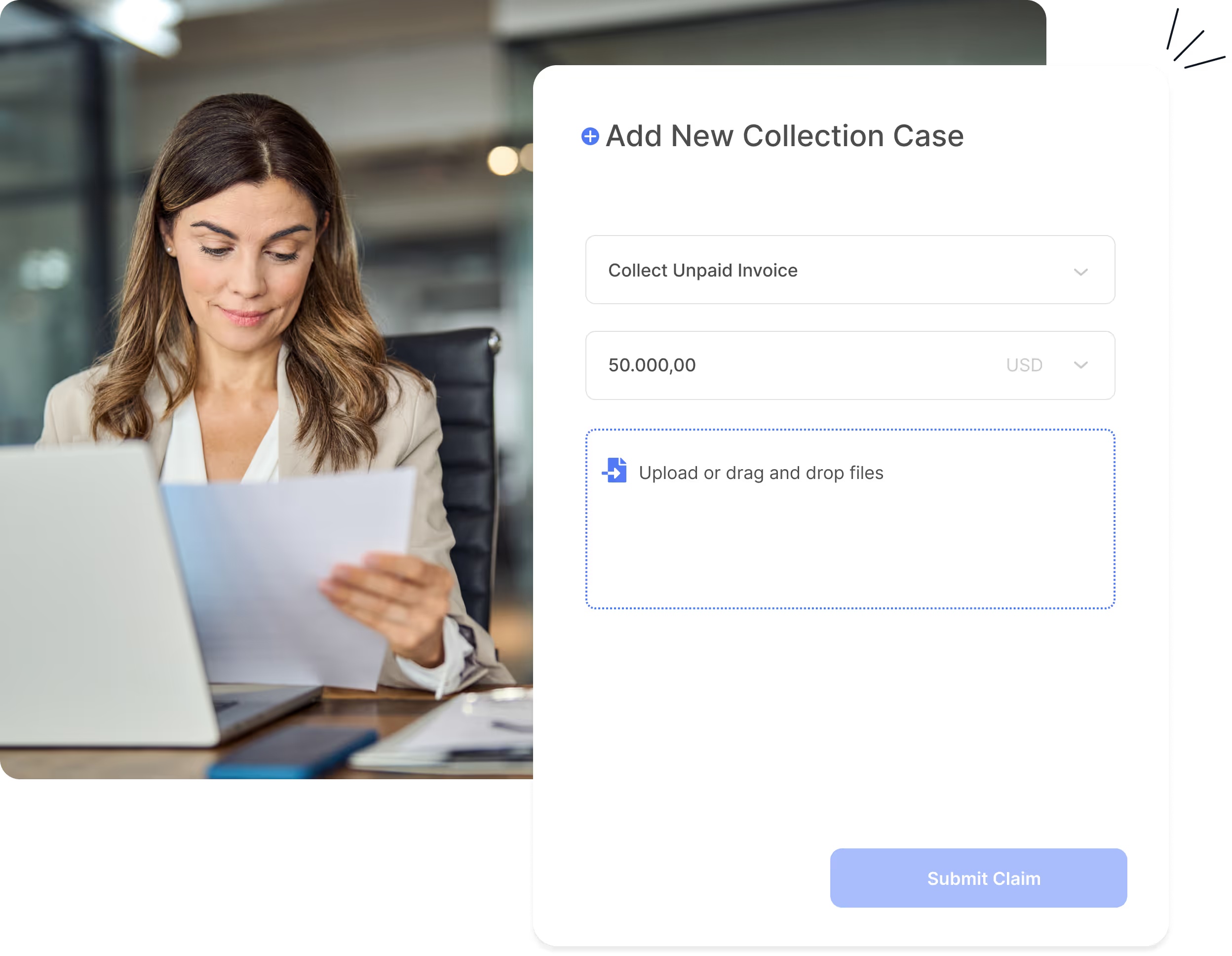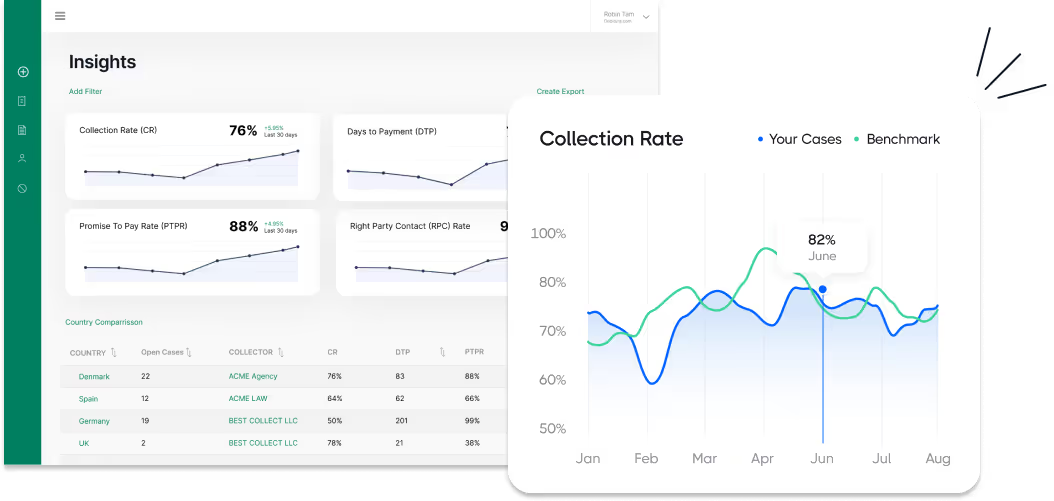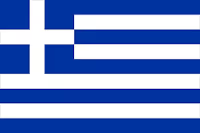Premier Debt Collection in Finland
Your trusted debt collection agency in Finland. Upload your claim for swift, reliable recovery with no upfront fees. For a comprehensive understanding of local debt collection practices, explore our in-depth guide.






The Ultimate Guide to Debt Collection in Finland
Why you can trust this guide
At Debitura, we uphold the highest standards of impartiality and precision to bring you comprehensive guides on international debt collection. Our editorial team boasts over a decade of specialized experience in this domain.
Questions or feedback? Email us at contact@debitura.com — we update this guide based on your input.
Debitura By the Numbers:
- 10+ years focused on international debt collection
- 100+ local attorneys in our partner network
- $100M+ recovered for clients in the last 18 months
- 4.97/5 average rating from 600+ client reviews
Expert-led, locally validated
Written by Robin Tam (16 years in global B2B debt recovery). Every page is reviewed by top local attorneys to ensure legal accuracy and practical steps you can use.
Contributing local experts:
Last updated:
Welcome to "The Ultimate Guide to Debt Collection in Finland," your premier resource for navigating the complexities of debt recovery in Finland. Debitura, with our extensive local knowledge and global expertise, is your leading partner in reclaiming your finances. Allow us to guide you through every step of the Finnish debt collection process, ensuring a seamless, efficient, and satisfactory resolution.
Exploring the Key Figures in Finnish Debt Collection
In Finland, debt collection is managed through a consortium of key actors, each playing a pivotal role. Understanding who these players are and their functions is crucial to navigating the debt recovery landscape effectively:
Debt Collection Agencies in Finland
Debt Collection Agencies in Finland are responsible for the voluntary phase of the collection process, focusing on securing payments through negotiation and communication before initiating legal proceedings. They operate under the Finnish Debt Collection Act, ensuring adherence to ethical practices. Typically involved in sending payment reminders and negotiating payment plans, these agencies must register with the South Finland Regional State Administrative Agency to operate legally. Their actions are confined to the bounds of voluntary collection, without stepping into legal enforcement or court procedures.
Debt Collection Lawyers in Finland
For cases demanding intricate legal intervention or when a debtor disputes a claim, Debt Collection Lawyers offer their expertise. Specialized in the Finnish legal landscape surrounding debt collection, they provide comprehensive services from drafting demand letters to representing creditors in court. Their role is vital for navigating complex legalities and ensuring that creditors’ efforts to recover debts are within the legal framework governed by the Finnish Bar Association. Unlike collection agencies, these lawyers can directly pursue legal action in courts, embracing a broader spectrum of debt recovery tasks.
Source: Finnish Bar Association
Court Bailiffs in Finland
When voluntary efforts are exhausted, the role of the Enforcement Officer (ulosottomies) becomes critical. These officers undertake the judicial phase of debt collection following a court order, handling tasks from wage garnishments to asset seizures. Their operation is sanctioned under Finnish law, necessitating a structured legal process overseen by legal authorities. The involvement of an Enforcement Officer is a direct result of unsuccessful voluntary collection attempts, marking the transition to legal action.
Source: Kuluttajaliitto
Finish Debt Collection Laws and Regulations: Legal Framework
Understanding the stringent legal framework in Finland is crucial for efficient and ethical debt recovery. This entails not only legal compliance but also the achievement of fair and effective debt recovery, a cornerstone for upholding a reputable presence within the market.
The Civil Court System of Finland
Finland's legal system is founded on a Civil Law tradition with an organized judiciary designed to address claims based on their nature and complexity:
- District Courts: Act as the first instance for most civil and criminal cases, including debt recovery matters.
- Courts of Appeal: Serve as the second instance for cases appealed from District Courts.
- Supreme Court: Stands as the highest judicial authority in Finland, dealing with cases that serve legal or public interest upon appeal.
It’s essential for international creditors to understand that Finnish courts prioritize negotiation and settlement between parties before proceeding to litigation, which is regulated by the Code of Judicial Procedure (Oikeudenkäymiskaari).
Source: Finnish Justice System
Key Legislation Governing Debt Collection in Finland
The collection of debts in Finland is subject to an array of laws ensuring structured and fair practices:
- Debt Collection Act: Regulates the conduct of debt collection agencies, focusing on voluntary debt recovery and laying out debtor and creditor rights, including procedural timelines and permissible fees.
- Interest Act: Governs the imposition of interest on overdue invoices, calculating interest based on the reference rate set by the Bank of Finland.
- Enforcement Act: Details the process for executing court judgments, including debt recovery through asset seizure or wage garnishment.
Adherence to these laws ensures that all debt recovery efforts are conducted within the bounds of Finnish law, highlighting the importance of understanding specific requirements and legal limits.
Source: Finlex
Consumer Protection in Debt Collection in Finland
The Finnish legislative framework ensures consumer protection against unfair collection practices, with several laws playing a pivotal role:
- Consumers are shielded from misleading information and unnecessary harm or costs during the collection process, as dictated by the Debt Collection Act and Consumer Protection Act (Kuluttajansuojalaki).
- Debt Collection must not breach the Consumer Protection Act, which prohibits excessive fees and enforces the right of consumers to clear, truthful information regarding their debts and the collection process.
- Collection agencies are mandated to respect the debtor's privacy, making it illegal to disclose details of the debt to third parties inappropriately.
- Provisions also exist within the Act on the Protection of Privacy in Electronic Communications safeguarding consumers from intrusive collection tactics.
Through robust legislative protections, Finnish law balances the interests of creditors with the rights of consumers, ensuring the fair and respectful treatment of debtors throughout the debt collection process.
Source: Finlex
Exploring Pre-Legal Debt Collection in Finland
In Finland, pre-legal debt collection entails an amicable resolution to recovering debts outside of courtroom procedures, typically conducted by specialized agencies. This section delves into the regulated steps and considerations for a successful amicable collection effort.
- Initial Notification: Creditors initiate the process with a payment reminder 14 days post-invoice due date. Source: Oikeus.fi, Intrum.
- Communication Ethics: All contact must be clear, respectful, and protect debtor's privacy. Source: Kilpailu- ja kuluttajavirasto.
- Interest and Fees: Creditors may apply an 11% default interest rate post-due date. Source: Oikeus.fi, Kilpailu- ja kuluttajavirasto.
- Legal Escalation: Unsuccessful amicable attempts can escalate to legal action. Source: Intrum.
- Statute of Limitations: Finnish law allows 15 years to enforce debt recovery legally. Source: Oikeus.fi, Takuusäätiö, Lowell.
- Collection Steps: Includes sending reminders and collection letters before legal action. Source: Intrum.
- Payment Arrangements: Law supports manageable repayment plans for debtors. Source: Minilex, Takuusäätiö.
- Retention of Title: Utilized restrictively, focusing on fixed assets. Source: General information.
- Documentation: Essential for a lawful process and proving debt claims. Source: Kuluttajaliitto, Minilex.
- Amicable Recovery Costs: Regulated costs emphasize transparent debtor communication. Source: Kilpailu- ja kuluttajavirasto, Oikeus.fi.
Exploring Cooperative Debt Recovery in Finland
Cooperative debt recovery in Finland is centered on a harmonious approach that underscores mutual respect and constructive dialogue, rather than conflict. This method is designed to keep the relationship between creditor and debtor intact, focusing on agreeable resolutions that are mindful of the debtor's circumstances while also safeguarding the creditor's interests in recouping funds. Adopting a non-confrontational stance, this approach is ideal for uncontested claims, sidestepping the legal system's intricacies and associated expenses.
Amicable or out-of-court debt collection is often the preferred first step unless faced with contested claims or intricate legal matters.
The Integral Role of Collection Agencies in Facilitating Smooth Recovery
In the realm of smooth debt recovery in Finland, collection agencies play a critical role, particularly when creditors are either too occupied or lack the necessary skills for efficient debt retrieval. Entities such as Debitura excel in this area, beginning with the accurate pinpointing of debts and debtors, and proceeding to establish contact via gentle reminders or formal notifications. Their neutral perspective, free from emotional involvement, frequently paves the way for more effective debt resolution by offering unbiased, expert mediation.
Benefits of Choosing Cooperative Debt Settlement
Embracing cooperative debt collection is advantageous for all involved parties; creditors avoid the financial burden of legal proceedings and maintain invaluable business connections thanks to the method's considerate nature. Debtors benefit from more lenient repayment options, alleviating economic pressure and nurturing a positive disposition towards the creditor. This method promotes dignity and compassion, setting an ideal stage for honoring financial commitments.
Shifting from Cooperative to Judicial Debt Collection
Although cooperative debt collection presents numerous advantages, certain circumstances may necessitate the contemplation of legal action. Indicators for transitioning to judicial collection include a lack of response, consistent failure to uphold commitments, or intentional avoidance by the debtor. This decision should be made with caution, recognizing the substantial expenses and duration associated with legal processes, and is generally regarded as a last resort after all cooperative avenues have been thoroughly explored.
Judicial Debt Collection In Finland
When debts remain unsettled, judicial debt collection involves obtaining a court order, usually handled by legal professionals. Explore the key aspects of this process in Finland below.
- Court Costs: In Finland, judicial debt collection involves court fees and legal expenses, which can vary based on case complexity.
- Legal Process Timeline: Understanding the timeline, from payment reminders to court proceedings, is essential for managing debt recovery expectations.
- Court System Hierarchy: Finland's legal system for debt collection involves the District Court, with small claims managed in a simplified process.
- Judicial Debt Recovery Laws: Finnish laws govern the judicial debt collection process, ensuring compliance and effectiveness in debt recovery.
- Selecting the Right Court: Choosing the appropriate court, considering factors like claim size and complexity, is crucial for a successful debt recovery in Finland.
- Small Claims Process: Finland offers a simplified legal route for straightforward debt disputes, focusing on efficiency and reduced legal costs.
- Formal Judgment Importance: A court order is a powerful tool in debt recovery, enabling enforcement actions like asset seizure or wage garnishment.
- Initiating Legal Action: The process starts with a summons letter, marking the transition to formal legal proceedings for debt recovery.
- Debtor's Response: The debtor's reaction to the summons can significantly influence the proceedings' direction, potentially leading to a court hearing or a default judgment.
- Alternative Dispute Resolution (ADR): ADR offers a cost-effective and quicker alternative to court battles in Finland, preserving business relationships while resolving disputes.
Shifting from Amicable to Judicial Debt Collection in Finland
The move from amicable to judicial debt collection occurs when voluntary efforts to collect a debt fail, marking a shift towards legal enforcement measures. This pivotal transition is typically triggered by disputes over the debt or the debtor's failure to comply with payment agreements. Securing legal counsel or representation becomes essential in navigating the judicial landscape and optimising the chances of recovery. Engaging a professional at this stage ensures that the creditor is well-prepared for the legal actions that follow, enhancing the prospect of a favourable outcome.
The Importance of a Formal Judgment
A formal judgment or court order is a pivotal tool in debt recovery, essentially enabling creditors to enforce their claims against debtors. Obtaining such an order demonstrates that a legal authority has recognized the validity of the creditor's claim, paving the way for measures such as asset seizure or wage garnishment to recover the debt. To secure a court order, a creditor must initiate legal proceedings, providing evidence and documentation (such as invoices or contracts) that substantiates the claim. This process underscores the seriousness of the debt obligation and reinforces the creditor's position.
Determining the Appropriate Court for Your Claim
In Finland, the determination of the appropriate court for a debt collection case hinges on factors such as the claim's size and complexity. The District Court is commonly approached for debt recovery issues, serving as the primary venue for initiating legal proceedings. Claims involving smaller amounts and less complexity might qualify for the streamlined small claims process, offering a cost-effective and expedient legal pathway. For cross-border claims within the EU, the European Payment Order facilitates recoveries across member states, showcasing the diversity of options available to creditors.
Small Claims Court in Finland
Finland's approach to small claims does not adhere to a fixed monetary threshold but instead considers the qualitative content of a case. While not labeled explicitly as a "Small Claims Court," the District Court manages these matters, employing a simplified process for cases that do not demand extensive legal examination. This process benefits creditors by offering a quicker resolution and potentially lower legal costs, making it an attractive option for straightforward debt recovery cases.
Ordinary Proceedings in Finland
Ordinary proceedings in Finland's judicial system come into play for more complex debt recovery cases or when amicable collection efforts have been exhausted. This method entails a more thorough legal examination, involving the submission of a detailed claim, evidence contention, and, potentially, courtroom debates. While ordinary proceedings may extend the timeline for debt recovery, they offer a comprehensive legal avenue to address and resolve claims that involve significant disputes or larger sums. Navigating this process with skilled legal representation is crucial to safeguarding the creditor's interests and achieving a favorable judgment.
With Debitura's extensive experience in debt recovery across Finland, creditors can rely on our expertise to guide them through the judicial collection process effectively. Our commitment to providing clear, authoritative, and actionable insights ensures that creditors are well-equipped to pursue their claims, from initiating legal action to enforcing court decisions.
Debt Enforcement in Finland
Debt enforcement in Finland plays a crucial role in the effective recovery of debts, ensuring a structured and legal process for creditors. This section explores key processes, legal requirements, and player roles in debt recovery.
- Court Order: A court judgment is essential before embarking on debt enforcement actions.
- Authorized Entities: Only bailiffs are authorized to enforce debts, requiring specific documentation.
- Mandatory Legal Steps: Court approval is mandatory, with substantial legal consequences for debtors.
- Legal Framework: The "Act on Debt Collection" and "Enforcement Code" govern debt enforcement and bailiff activities.
- Role of Bailiffs: Bailiffs play a pivotal role in debt recovery, with duties including asset seizure and salary attachment.
- Financial Considerations: Costs associated with bailiff services and their impact on ROI must be considered by creditors.
- Asset Tracing: Businesses can utilize asset tracing as part of debt preparation to evaluate hidden assets.
- Timeframe: The debt enforcement process has a typical duration, influenced by case specifics.
- Asset Seizure: Legal procedures exist for the seizure of both tangible and intangible assets, with police and bailiff authority.
- Salary Attachment: A clear framework defines the garnishment of salaries, including protected portions and debtor rights.
- Debtor Rights: Debtors are afforded rights and protections, including mechanisms to contest garnishment.
- Protection Laws: Specific laws are in place to safeguard debtors from undue hardship during enforcement.
The Role of Bailiffs in Debt Enforcement
In Finland, bailiffs play a critical role in the debt enforcement process, tasked with executing the collection of debts through legal means once a creditor has obtained a court judgment or when the debt is deemed directly enforceable. Their responsibilities span a wide range of actions aimed at ensuring the efficient and lawful recovery of debts.
- Notification and Disclosure: Bailiffs are responsible for informing the debtor about the enforcement process, conducting asset searches, and providing an enforcement disclosure where the debtor must declare their financial situation.
- Seizure of Assets: If necessary, bailiffs can proceed with seizing assets or wages. They have broad rights to access various registers to locate the debtor’s assets and may enter premises to seize property with police assistance if required.
- Legal Enforcement: Bailiffs not only facilitate asset seizure but also garnish wages as part of the enforcement procedure, ensuring that a part of the debtor's earnings is allocated for debt repayment.
Source: Ulosottolaitos
The Process of Debt Enforcement
The debt enforcement process in Finland is multifaceted and designed to ensure debts are collected in a manner that is fair and lawful. The process unfolds in specific stages, from the initial court judgment to the eventual seizure of assets or garnishment of wages.
- Court Judgment: The process begins with the court's ruling, declaring the debt enforceable, allowing bailiffs to proceed with the collection efforts legally.
- Notification: Debtors are notified by the bailiff of the impending enforcement actions, providing them an opportunity to voluntarily comply.
- Seizure and Garnishment: If voluntary compliance is not met, bailiffs can seize assets and garnish wages to satisfy the debt, adhering strictly to procedures defined by Finnish law.
Legal Framework for Bailiff Operations and Debt Enforcement
The legal foundation for bailiff operations and debt enforcement in Finland is robust, governed by several specific laws and codes that outline the boundaries and procedures of debt collection efforts.
- Primary Laws: The "Laki saatavien perinnästä" (Act on Debt Collection) and the "Ulosottokaari" (Enforcement Code) serve as the legal bedrock for bailiff operations, detailing the legal basis for debt collection activities and enforcement procedures.
- Court Involvement: The legal process necessitates court involvement, especially in declaring debts enforceable, which is a prerequisite for bailiffs to initiate enforcement actions.
- Protection of Rights: The legal framework is carefully structured to balance the pursuit of debt recovery with the protection of debtors' rights, including mechanisms for financial support for legal costs and opportunities to contest inaccuracies in the enforcement process.
Pre-enforcement Actions
Efficient preparation and understanding of the Finnish debt collection process are essential for successful enforcement actions. This involves a series of pre-enforcement actions centred around the reconciliation attempts and legal prerequisites.
- Initial Collection Efforts: These involve sending reminders and demand letters for payment, providing opportunities for debtors to voluntarily settle their debts before legal proceedings commence.
- Interest and Fees: Interest on the outstanding amounts and potential collection fees begin to accrue during these initial stages, necessitating swift resolution to minimize additional costs.
- Legal Proceedings: Should voluntary efforts fail, creditors may proceed with legal action, which involves obtaining a court judgment that formally recognizes the debt as enforceable, a critical step before enforcement actions can be pursued.
Insolvency Proceedings in Finland: A Creditor's Guide
In Finland, insolvency or bankruptcy proceedings signify a structured process for recovering debt from financially distressed entities. This section delves into the intricacies of utilizing insolvency as a debt collection strategy, focusing on creditor perspectives.
- Last Resort Strategy: Bankruptcy is considered a final measure for debt recovery when other methods fail.
- Governing Legislation: The Finnish Bankruptcy Act (Konkurssilaki) outlines procedures for declaring bankruptcy.
- Filing Requirements: Bankruptcy petitions can be submitted by creditors or debtors to the district court.
- Priority Rules: Secured creditors have precedence over unsecured ones, influencing recovery likelihood.
- Associated Costs: Costs include court fees and bankruptcy administrator's fees, paid from the estate.
- Timelines: Bankruptcy proceedings duration varies, potentially lasting months to years.
- Expected Outcomes: Creditors typically receive asset distributions based on claim priority, yet total recovery is uncertain.
- Process Steps: The process involves filing a petition, court hearing, and decision-making stages.
- Secured vs. Unsecured: Secured creditors enjoy certain rights and privileges over unsecured creditors.
- Post-Bankruptcy Recovery: Creditors may pursue future assets for remaining debts, especially from individual debtors.
- Documentation: Creditors must submit detailed claims including amount, basis, and supporting documentation.
- Creditor's Role: Creditors can influence the process, challenge claims, and vote on decision-making aspects.
The Legal Framework for Insolvency Procedures
The insolvency framework in Finland is designed to provide an orderly process for the resolution of insolvent entities. It encompasses various insolvency proceedings tailored to different situations, governed by comprehensive legislation.
- Regular Insolvency Proceedings and Self-Administration: Governed by the Finnish Bankruptcy Act (Konkurssilaki), these proceedings apply to individuals, companies, and other legal entities. The process involves the liquidation of a debtor's assets to pay off creditors.
- Protective Shield Procedure: Similar to corporate restructuring, this procedure aims at rehabilitating financially troubled companies, potentially allowing for debt reduction or rescheduling.
- Thresholds and Conditions for Declaring Insolvency: Insolvency is defined as the inability to pay debts as they fall due, which is not merely temporary. Creditor-initiated bankruptcy is possible, highlighting insolvency as a recovery strategy.
Creditor's Rights and Priorities in Insolvency Proceedings
Understanding creditor's rights and the priority of claims is crucial in insolvency proceedings.
- Ranking and Priority of Claims: Finnish law stipulates a hierarchy, with secured creditors given precedence over unsecured creditors in asset distributions.
- Insolvency Table and Registration of Claims: Creditors must register their claims to be eligible for any distributions, with processes in place for claim disputes and adjustments.
Source: Konkurssiasiamies
Maximizing Recovery from Insolvent Estates
Taking strategic steps can increase the chances of maximizing recovery for creditors.
- Prompt and accurate claim submission, including necessary documentation.
- Active engagement in the bankruptcy process, such as attending creditor meetings.
- Consideration of alternative dispute resolutions or settlements where applicable.
The Cost and Duration of Insolvency Proceedings
The financial and temporal aspects of insolvency proceedings vary depending on case complexity and debtor's estate size.
- Costs: Include court fees and bankruptcy administrator fees, with creditors sometimes bearing fees in unsuccessful cases.
- Duration: The process can span from several months to years, influenced by disputes, estate size, and creditors' number.
Insolvency procedures in Finland offer a structured approach for dealing with insolvent entities, providing a framework that balances the interests of debtors and creditors alike. Understanding the insolvency process, creditor's rights, and strategies for recovery can help navigate these challenging situations effectively. Debitura, with its decade of experience in debt recovery in Finland, stands as a reliable partner in managing insolvency-related cases efficiently and maximizing recovery potential for creditors.
Find a Local Debt Collection Lawyer
Need court-ready representation? Share your case once and receive up to three proposals from vetted litigation attorneys—free, fast, and with no commitment.
- Verified specialists
- Quotes in 24 h, no hidden fees
- Fair, pre-negotiated rates

Asianajotoimisto Advoline Oy is a premier law firm in Helsinki offering effective Debt Collection services in Finland, renowned for its expertise since 2007, and a proud member of Suomen Asianajajaliitto, ensuring trust and excellence in every case.

Backstrom & Co is a premier law firm in Helsinki offering effective Debt Collection services in Finland, positioning itself as the go-to partner for debt recovery since 1993, with accolades such as Best IP Litigator 2016 and memberships in Eurojuris International and INTA.

Attorneys Ltd Ulrika Larpes Consulting is a premier law firm in Helsinki offering effective Debt Collection services in Finland, established in 2011, with a membership in the Euro-American Lawyers Group and the Finnish Bar Association, providing multilingual services across multiple continents.

Intressi Oy Ltd is a premier debt recovery agency in Helsinki offering effective Debt Collection services in Finland, established in 2011, renowned for its customer-oriented approach and bilingual support, serving corporate clients with tailored solutions and legal expertise.

Nordic Law Oy is a premier law firm in Helsinki offering effective Debt Collection services in Finland, recognized since 1993 for its client-focused approach and accolades such as Who’s Who Legal: Fintech & Blockchain, with membership in the Finnish Fintech Association.





.svg)

.webp)
.png)

.png)
.svg)












.webp)